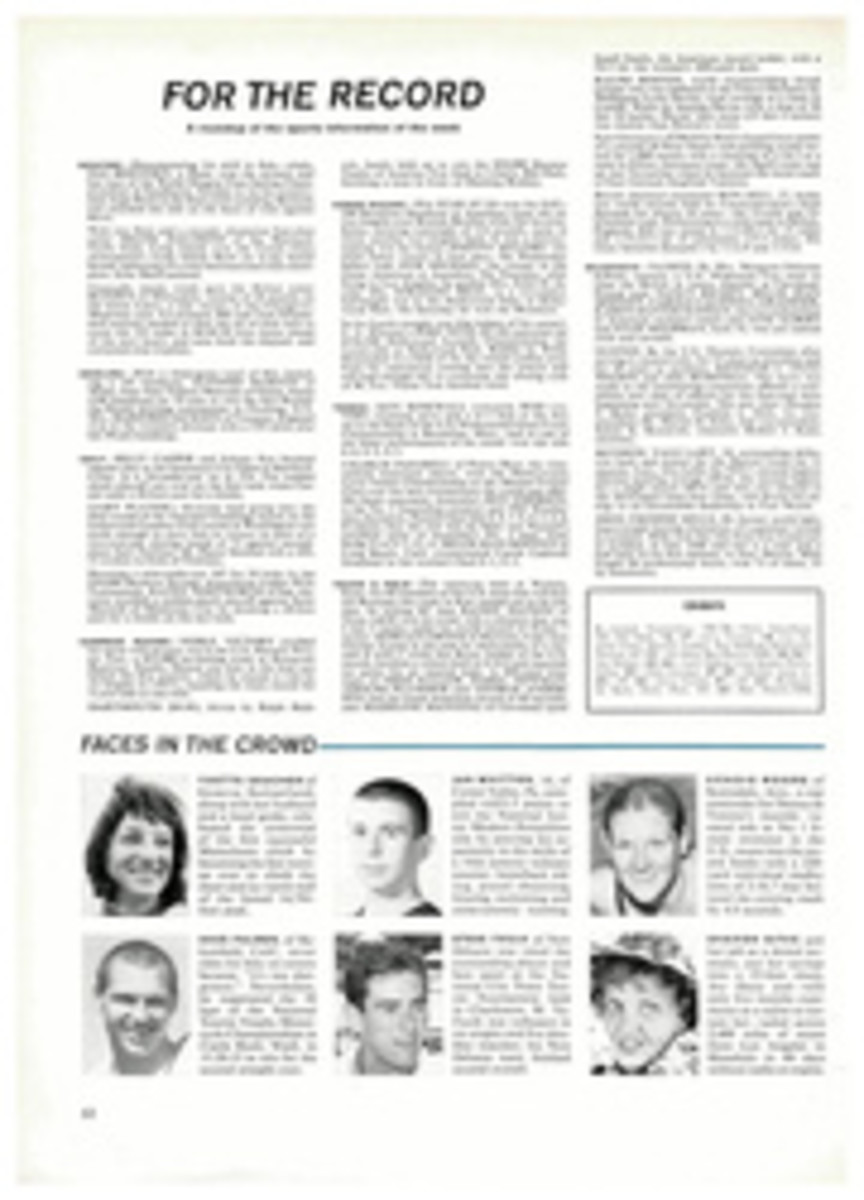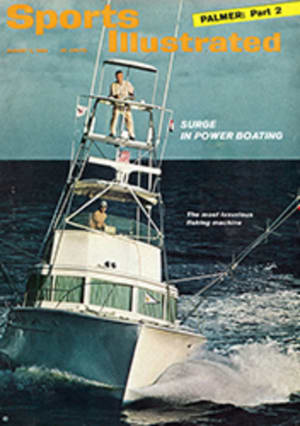
SANDY MAKES A PITCH FOR POSTERITY
Sandy Koufax sat on the padded bench in the third-base dugout at Dodger Stadium last week, the white towel draped around his neck accentuating the dark brown stubble on his handsome face. It was the last of the ninth inning against the Houston Astros, there were two outs and the score was tied 2-2. Then Jim Lefebvre walked and Jim Gilliam was walked intentionally to get at the next batter, Sandy himself. Manager Walter Alston, knowing the top of his batting order would be coming up in the 10th, decided to let the pitcher bat.
"I'm going to drive him in," said Koufax. He discarded the towel and his blue jacket, toted his bat to the plate and hit the first pitch between shortstop and third to score Lefebvre from second base and win his own game 3-2.
That is the kind of season it has been for Sandy Koufax, a man to whom great seasons, or at least great partial seasons, have become almost routine. With the invaluable aid of brightly colored capsules, two masseurs, gobs of red ointment and enough ice to build an igloo, Koufax has established a record of 17-3 and is well on his way to becoming the first pitcher to win 30 games in one season since Dizzy Dean did it in 1934, the year before Koufax was born. With his total of 222 strikeouts, he has an even better chance to surpass Bobby Feller's season strikeout record of 348, set in 1946. Finally, and not incidentally, Koufax, with the help of his pitching partner, Don Drysdale, and the base stealing of Maury Wills, is keeping the weak-hitting, injury-riddled Dodgers at the top of the National League standings, defying the laws of logic.
Indexed to date, this has been Koufax's greatest year: he has started 24 games and has pitched nine or more innings in 18 of them. Only twice has he been hit hard and neither time was he charged with the loss. The three games he did lose were by scores of 4-3, 6-3 and 2-1, and the last of them was on May 26. Since then he has won 11 in a row and has been almost untouchable. Assuming he can start 16 more games, Koufax must win 13 to reach 30, which means that he must step up his already remarkable ratio of victories to games started, a difficult task.
The strikeout record seems more readily available. Whereas most pitchers traditionally depend on one pitch for strikeouts—their curve or fast ball—Koufax can strike out a batter with anything he throws, curve, fast ball or changeup, over each of which he has remarkable control. Koufax has averaged 9.3 strikeouts for his first 24 starts, and if he can continue that pace for 16 more games he will finish the season with some 370, well past Feller's 19-year-old record.
His Dodger teammates enjoy talking about Koufax but, with the ballplayer's traditional superstitiousness, they do not want to discuss 30 victories and/or 348 strikeouts any more than he does. All that Sandy will say is that—in another grand tradition of baseball—he thinks about just one game at a time. "You're talking about 30 wins and that's a lot," says Pitching Coach Lefty Phillips. "Both Drysdale and Koufax, every time they pitch, give a good account of themselves. The hot months, August and September, won't bother Sandy. He's pitched pretty consistently, unless he's been hurt."
Unless he's been hurt. Unless, but, except and if. These are the words that must haunt Sandy Koufax beneath his mild, nice-guy exterior.
"Do you know what's been really great about this season?" Koufax said recently. "So far I haven't missed a single turn. Win or lose, I've been able to pitch every four days."
No one could possibly appreciate the significance of this more than Koufax himself, for there have been times during the last four seasons when it looked as though he would never pitch again. In July of 1962 he was ripping along with more than 200 strikeouts and a 14-5 record when he developed a clot in the deep ulnar arch of his precious left palm. Eventually it affected the index finger on his left hand, and for a while there was danger that the finger would have to be amputated. Sandy was for all practical purposes through for the season—and so were the Dodgers.
Disease, injury and opposing batsmen did not bother him in 1963, when he won 25, lost five and struck out 306 for a National League record, but early last August he dived into second base in a game against Milwaukee and hurt his left elbow. Although he took his next two turns on the mound and won both games, the elbow became painful and useless. He did not pitch the rest of the year, departing with a 19-5 record, 223 strikeouts and a 1.74 earned run average, the best in the league.
When Dean Chance won the Cy Young award last year he said in a moment of remarkable humility, "I'm not the best pitcher. Koufax is. He may be the greatest pitcher who ever lived. Everyone knows he can't be beat when he's right. That's what you call a pitcher. I really admire him."
Sandy did not touch a baseball in the off season, and when he came into camp this spring he was as "right" as ever. For about a month. Then he had to leave Vero Beach and fly to Los Angeles for treatment of a "traumatic arthritic condition of the left elbow." The elbow joint was filling with fluid, as in water on the knee. The doctors said it had been developing for a "considerable time." Tremors ran through Florida, California, Wall Street and Walter O'Malley's heart.
There was speculation that this time Koufax was really through, out of baseball just as he reached the juicy $70,000 bracket. But after some treatment the doctors said he probably would be able to pitch once a week. Finally, after he pitched well at the end of spring training, they allowed him to take his regular turn. The Dodgers would settle for once a week if they had to, but—cross your fingers, knock on wood, say a prayer—they have not had to.
Koufax' physical well-being is entrusted to the team physicians, Dr. Robert Woods and Dr. Robert Kerlan, and Trainers Wayne Anderson and Bill Buhler, expert rubbers and kneaders. Sandy is sensitive to inferences that he is a house orchid in need of constant loving care, and friends are quick to defend him.
"I've read reports that Sandy Koufax is a guy who lays on tables and gets worked on two hours at a time," says Anderson. "It's not true and it's not fair. People will begin to think he's a hypochondriac.
"He's been an unfortunate guy. He's got guts. I've seen him whip things that would make other people go home and get the lunch pail. He's had two serious ailments. The guy has a big heart."
Big back muscles, too. More muscular than any pitcher Anderson has seen in 18 years in the big leagues. He says Sandy has even bigger back muscles, in fact, than Ted Kluszewski, the King-Kongish citizen who used to make pitchers tremble when he came to bat for Cincinnati in his sleeveless shirt. Although the muscles help explain Sandy's great fast ball, they also make it difficult for him to get loosened up properly much before the third or fourth inning of a ball game. In two of his three losses he was in trouble early, and it was in the second inning that Houston scored its two runs against him last week. After that, zero.
One thing that helps Koufax loosen up is Capsolin, an evil-looking red ointment that should be handled only by people with asbestos instead of flesh on their hands. Someone, as a gag, smeared some of it over the team photographer's back a few seasons ago and the poor man had to be treated for shock.
"Sandy needs a lot of Capsolin, more than any pitcher I've ever seen," says Anderson. "We put a whole tube of it on his shoulder and back. Don Newcombe is the only guy who ever came close to using as much."
In addition, Koufax gets a light back rub and a light arm stretch. Fifteen minutes before the game he is completely dressed and ready to throw on the sidelines, building up to the last few pitches, which he throws just as hard as if he were in a game.
During the game Sandy's left arm swells. "You measure the whole arm before and after the game," said Dr. Woods, "and there's a tremendous difference. Most pitchers' arms swell but on Sandy it's a very definite change in size, as much as an inch, especially up around the shoulders—the upper arm. The reason for this is he's using centrifugal force that propels a great deal of blood into the arm and the blood doesn't get a chance to come back because he's repeating the action time after time after time."
Trainers Buhler and Anderson reduce the swelling after the game by having Koufax stick his elbow in a sink full of ice for 20 to 30 minutes. To prevent his skin from being burned by the ice, he puts his arm through two cutoff wind-breaker sleeves before submerging. If there is no sink available on the road, he uses a bucket or anything else that is handy. Application of a pregame ointment is an old routine, but he has been getting the frozen-daiquiri treatment only since the arthritis was discovered.
A medical expert could look at the Koufax index finger today and find no trace of the former trouble, but there always is a threat that the arthritis in Sandy's elbow will knock him out of the starting rotation and ruin the Dodgers' pennant chances. Before and after he pitches he takes Butazolidin alka, orange-and-white capsules that are described by Dr. Kerlan as an "anti-inflammatory medication you cannot take promiscuously. You have to take it under rigid control."
"He still gets swelling between games," says Dr. Kerlan. "Nobody knows when it will swell too much. He's bound to have another flare-up sometime, just as sure as the sun sets."
The Dodgers are praying that the sun will not set before late October—and will rise again in March.
[originallink:10527376:42809]
PHOTO
Following through In classic style, Sandy Koufax puts the finishing touch on another strikeout.
PHOTO
HERB SCHARFMAN
Before pitching, game's most valuable arm is massaged with hot ointment by Dodger trainer.
PHOTO
After pitching, arm gets 30-minute bath in basin of ice water to reduce inevitable swelling.

